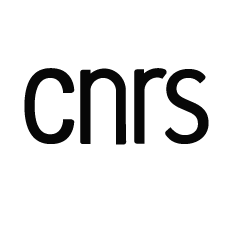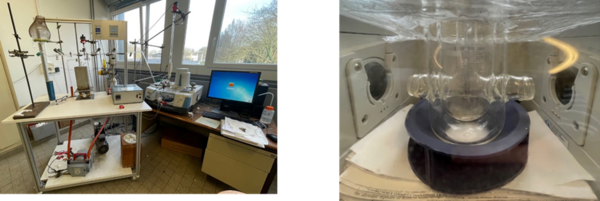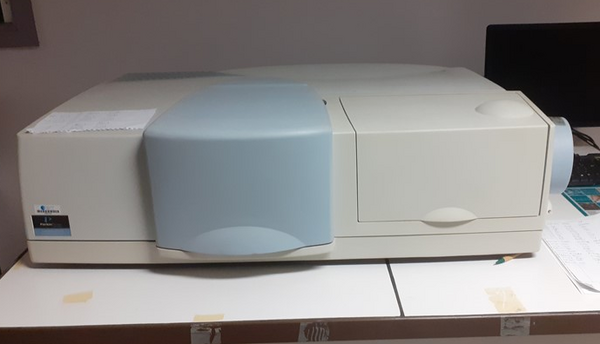Vibrational and UV-Visible spectroscopies
Scientific manager :
Contact :
Staff :
| Lens Campus | Jean-François Blach Nicolas Kania |
| Lille Campus | Christophe Dujardin Jean-Charles Morin Mélanie Dubois Elise berrier Martine Trentesaux |
Presentation
The vibrational and UV-visible spectroscopy platform provides researchers with tools for characterizing solids (catalysts, bulk compounds, plate deposits, etc.) and liquids (aqueous solutions, impregnation solutions, reaction mixtures, etc.).
The platform includes :
- 5 infra-red spectrometers for analyzing solids or liquids, including acid-base sites measurements.
- 2 Raman spectrometers equipped with various accessories offering a wide range of possibilities, including powder analysis, mapping, liquid analysis and the possibility of carrying out experiments under in-situ conditions.
- 2 UV-Visible spectrometers equipped with an integrating sphere for analyzing liquids and solids
Vibrational spectroscopies
In a molecule present in a solid or liquid, the position of the atoms varies minutely (distances, angles). Rotational movements can be added in the case of gases. These movements are collectively referred to as vibrations, vibrations which correspond to (quantified) transitions between energy levels of the molecule. By studying these transitions, vibrational spectroscopy thus allows the identification of atomic groups in a given molecule. Two types of vibrational spectroscopy are used to determine the structure of molecules:
- Infrared (IR) Spectroscopy: This absorption spectroscopy is particularly used for the study of organic molecules' functions but can also be dedicated to the study of inorganic materials.
- Raman Spectroscopy: Based on the physical phenomenon of scattering, this spectroscopy is complementary to IR. It also allows the study of organic or inorganic compounds and is often indispensable for a number of materials for which IR proves ineffective.
Remarkable Equipments
Infrared (IR)
For routine characterizations, 3 equipments are available on the plateform:
- FT-IR iS50 spectrometer equipped with an ATR module (Nicolet Thermo Fisher Scientific) Cité scientifique site in Villeneuve d'Ascq
- Shimadzu Prestige 21 spectrometer, Université d'Artois site, Lens
- Spectrometer Perkin Elmer Spectrum Two site Université d'Artois à Lens
These equipments are dedicated to the identification of species present in a wide range of organic and inorganic materials (catalysts, powders, bulk compounds, liquids, etc.). Spectra are obtained in wave numbers ranges from 80 to 4000 cm-1.
ATR-FTIR (ATR = Attenuated Total Reflectance) is a non-destructive sampling technique that enables infrared characterization of a material without any preparation. In fact, for materials that are more or less transparent to infrared radiation, the classic methodology is to prepare a thin pellet of KBr into which a small quantity of sample is introduced. Preparing this pellet can be long and difficult, and the sample is lost; this methodology does not allow the study of liquids for which a dedicated cell is required. The ATR module allows to study the sample as it is. This makes it thus easy to obtain quality IR spectra (with quantitative informations) for any type of samples: solids, liquids, pastes, powders, plates, finished products...
The characteristics of the 3 instruments vary slightly:
- FT-IR iS50: all types of samples - routine analysis...
- Prestige 21: can work in transmission or ATR mode (diamond or Germanium specific for dark materials such as activated carbons). It is also equipped with a MCT detector more sensitive than a conventional one.
- Spectrum Two: compact device with ATR.
Sample preparation is carried out by the platform. On request, results can be interpreted in collaboration with the applicant.
This equipment allows the identification and quantification of acid sites on solids.
Nicolet iS 50 FTIR coupling for CO adsorption at room temperature and low temperature (100K)
This equipment allows the adsorption of carbon monoxide on solids.
Depending on the operating temperature and the nature of the solid, it is possible to study the acid and/or metal sites
Raman
Raman spectroscopy is a vibrational spectroscopy (based on the physical phenomenon of diffusion) that provides complementary information to infrared spectroscopy (absorption spectroscopy).
This equipment is dedicated to the identification of species present in many organic or inorganic materials (on the 'surface' of a catalyst, on plates, powders, bulk compounds, liquids, etc.). One of the advantages of using Raman to study certain materials is that the presence of water does not interfere with the Raman signal (water scattering is very low). This technique is therefore very effective for characterizing aqueous solutions, supported catalysts, etc.
This spectrometer is equipped with 2 laser sources (532 nm: green and 785 nm: red), 4 gratings (600 to 2400 lines / mm), which allows the spectra recording conditions to be optimized according to the user's needs in a range of wave numbers from 100 to 4000 cm-1.
This spectrometer is mainly used in micro-Raman mode. It is equipped with an optical microscope that can be used to select (and characterize) if necessary several zones on the sample (for example to check its homogeneity…). This microscope can also be used to zoom in on a particular area, so that the laser beam can be focused more or less on the sample (and the laser power received by the sample can be adjusted to optimize signal intensity). By focusing the laser beam strongly and increasing the laser power, it is even possible to locally simulate the temperature behavior (calcination) of certain samples, which can rise sharply on a micrometric scale. For samples that are unstable at high temperatures, it is possible to significantly reduce the laser power (either by adding filters to the incident laser path, or by defocusing the beam).
A motorized xy-z stage can be used to map samples.
The spectrometer is also coupled to an optical fiber and a probe for in-situ immersion (or contact) measurements in liquid media (corrosive or not).
Finally, the instrument can be connected to a Mantis Harrick Prying Cell for in-situ studies (catalytic, etc.).
Raman Spectrometer Horiba Labram HR800 – Université d’Artois, Lens
This spectrometer is a high-resolution Raman, thanks to its 80 cm focal length and 1,800-line grating (resolution of the order of 0.3 cm-1). However, it can be used in low-resolution mode if required (equipped with a 2nd dispersion grating). It operates in micro-Raman mode (with an optical microscope) and is fitted with a motorized stage (removable), enabling mapping.
This spectrometer is Horiba's "research" model. The optical part is accessible and customizable, so it can be easily adapted if required (addition of lasers, filters, polarizers, half-wave plate, etc.). It can also be configured to work in the UV and/or near-IR range.
The downside of this modularity is that this spectrometer is a little less user-friendly than the XPlora for the occasional user. Another price to pay for this adaptability and resolution is brightness. In general, the HR is less sensitive than the XPlora.
Sample preparation is carried out on site. On request, results can be interpreted in collaboration with the applicant.
UV - VISIBLE
UV-Visible spectroscopy is an absorption spectroscopy involving electronic transitions. It can be used to identify species present in many organic or inorganic materials (catalysts, plates, powders, bulk compounds, liquids, etc.) and also to quantify these species (mainly for liquids). This spectroscopy is particularly suitable for identifying metal complexes.
The platform is equipped with 2 UV-Visible spectrometers:
UV-Visible Spectrometer Perkin Elmer Lambda 650 (cité scientifique, Villeneuve d’Ascq)
UV-Visible Spectrometer Shimadzu UV-2600 (Université d’Artois, Lens)
Both spectrometers are equipped with a permanent (Lambda 650) or removable (UV-2600) integrating sphere, enabling easy characterization of liquids (by transmission) and solids (by diffuse reflection) in the wavelength range 200 - 900 nm (Lambda 650) or 220-1400 nm (UV-2600).





![[Translate to English:] Spectromètre Raman Horiba Xplora Plus - site Cité scientifique à Villeneuve d’Ascq](/fileadmin/user_upload/laboratoires/uccs/Ressources_scientifiques/Spectroscopies_vibrationnelles_et_UV-Visible/Raman/Spectro_raman1.png)
